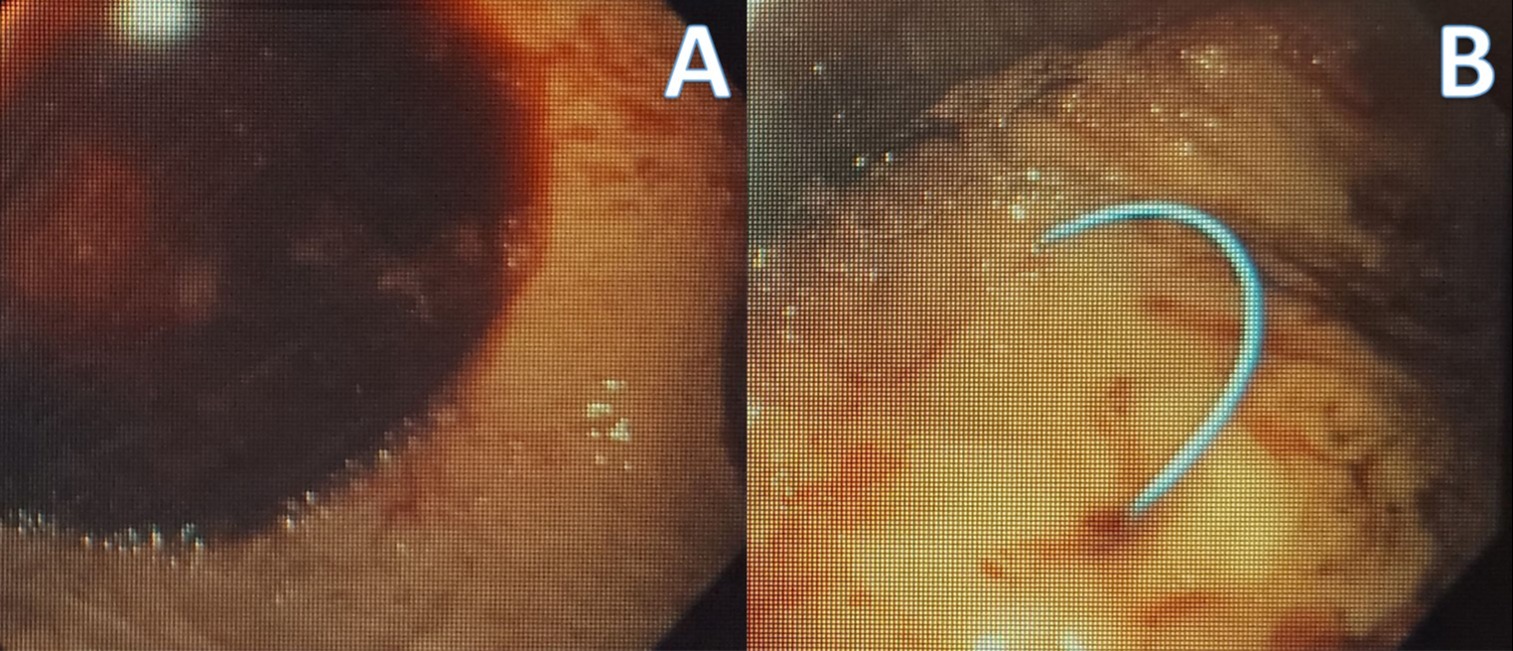Back
Poster Session C - Monday Afternoon
C0344 - An Unusual Cause of Upper Gastrointestinal Bleed: Temporary Epicardial Pacing Wire
Monday, October 24, 2022
3:00 PM – 5:00 PM ET
Location: Crown Ballroom

Raj Shah, MD
University of Central Florida HCA Healthcare GME
Kissimmee, FL
Presenting Author(s)
Award: Presidential Poster Award
Raj Shah, MD1, Seth Lipka, MD2, Basher Atiquzzaman, MD2
1University of Central Florida HCA Healthcare GME, Kissimmee, FL; 2Digestive and Liver Center of Florida, Kissimmee, FL
Introduction: A temporary epicardial pacing wire (TEPW) is frequently placed during cardiac surgery to treat postoperative arrhythmias. Gastrointestinal (GI) complications from TEPW are rare, and only a few have been described. Here we describe a rare case of upper GI bleed from TEPW traversing the stomach.
Case Description/Methods: A 76-year-old male with a past medical history of coronary artery disease (CAD) status posts two stents, myocardial infarction, chronic kidney disease, hypertension, and stroke presented to the emergency department with chest pain. The patient had a non-ST-elevation myocardial infarction (NSTEMI); coronary angiography showed multivessel CAD. He underwent coronary artery bypass grafting (CABG), following which the patient had 1200cc dark blood drained through the nasogastric tube. The patient underwent esophagogastroduodenoscopy (EGD), which showed a significant amount of fresh blood (Fig. A) and a suspicious linear object entering and exiting the gastric body (Fig. B). He underwent a celiac and left gastric artery angiogram with embolization of the injured branch of the left gastric artery. The foreign body removed from the stomach was identified as right ventricle TEPW. Repeat EGD showed no active bleeding.
Discussion: Epi-myocardium of the atria and ventricle are common sites for TEPW placement during cardiac surgery. They are tunneled to the outside through the left subcoastal margin. Poor sensing or capture, dislodgement, or retention are the most common complications. Other complication include bleeding from the right ventricular laceration with tamponade, avulsion of a side branch from a saphenous vein coronary bypass graft, and perforation of the superior epigastric artery. GI complications from this procedure are rare. Few reports of bowel perforation presenting as acute abdomen have been described. A case of dyspepsia due to gastric wall injury caused by the migration of TEPW into the gastric cavity has been described. To our knowledge, no case of upper GI bleed secondary to pacemaker wire misplacement has been described. Post-cardiac surgery patients are usually in the ICU. Therefore, if signs of GI bleeding are present in the postoperative period, EGD should be performed for diagnostic purposes. However, rarely displaced pacemaker wire may be one of the causes of GI bleeding, which should be on the physician's radar.

Disclosures:
Raj Shah, MD1, Seth Lipka, MD2, Basher Atiquzzaman, MD2. C0344 - An Unusual Cause of Upper Gastrointestinal Bleed: Temporary Epicardial Pacing Wire, ACG 2022 Annual Scientific Meeting Abstracts. Charlotte, NC: American College of Gastroenterology.
Raj Shah, MD1, Seth Lipka, MD2, Basher Atiquzzaman, MD2
1University of Central Florida HCA Healthcare GME, Kissimmee, FL; 2Digestive and Liver Center of Florida, Kissimmee, FL
Introduction: A temporary epicardial pacing wire (TEPW) is frequently placed during cardiac surgery to treat postoperative arrhythmias. Gastrointestinal (GI) complications from TEPW are rare, and only a few have been described. Here we describe a rare case of upper GI bleed from TEPW traversing the stomach.
Case Description/Methods: A 76-year-old male with a past medical history of coronary artery disease (CAD) status posts two stents, myocardial infarction, chronic kidney disease, hypertension, and stroke presented to the emergency department with chest pain. The patient had a non-ST-elevation myocardial infarction (NSTEMI); coronary angiography showed multivessel CAD. He underwent coronary artery bypass grafting (CABG), following which the patient had 1200cc dark blood drained through the nasogastric tube. The patient underwent esophagogastroduodenoscopy (EGD), which showed a significant amount of fresh blood (Fig. A) and a suspicious linear object entering and exiting the gastric body (Fig. B). He underwent a celiac and left gastric artery angiogram with embolization of the injured branch of the left gastric artery. The foreign body removed from the stomach was identified as right ventricle TEPW. Repeat EGD showed no active bleeding.
Discussion: Epi-myocardium of the atria and ventricle are common sites for TEPW placement during cardiac surgery. They are tunneled to the outside through the left subcoastal margin. Poor sensing or capture, dislodgement, or retention are the most common complications. Other complication include bleeding from the right ventricular laceration with tamponade, avulsion of a side branch from a saphenous vein coronary bypass graft, and perforation of the superior epigastric artery. GI complications from this procedure are rare. Few reports of bowel perforation presenting as acute abdomen have been described. A case of dyspepsia due to gastric wall injury caused by the migration of TEPW into the gastric cavity has been described. To our knowledge, no case of upper GI bleed secondary to pacemaker wire misplacement has been described. Post-cardiac surgery patients are usually in the ICU. Therefore, if signs of GI bleeding are present in the postoperative period, EGD should be performed for diagnostic purposes. However, rarely displaced pacemaker wire may be one of the causes of GI bleeding, which should be on the physician's radar.

Figure: A: EGD showing pooled blood in stomach giving definitive evidence of upper GI bleed.
B: EGD showing pacemaker wire traversing the stomach.
B: EGD showing pacemaker wire traversing the stomach.
Disclosures:
Raj Shah indicated no relevant financial relationships.
Seth Lipka indicated no relevant financial relationships.
Basher Atiquzzaman indicated no relevant financial relationships.
Raj Shah, MD1, Seth Lipka, MD2, Basher Atiquzzaman, MD2. C0344 - An Unusual Cause of Upper Gastrointestinal Bleed: Temporary Epicardial Pacing Wire, ACG 2022 Annual Scientific Meeting Abstracts. Charlotte, NC: American College of Gastroenterology.

